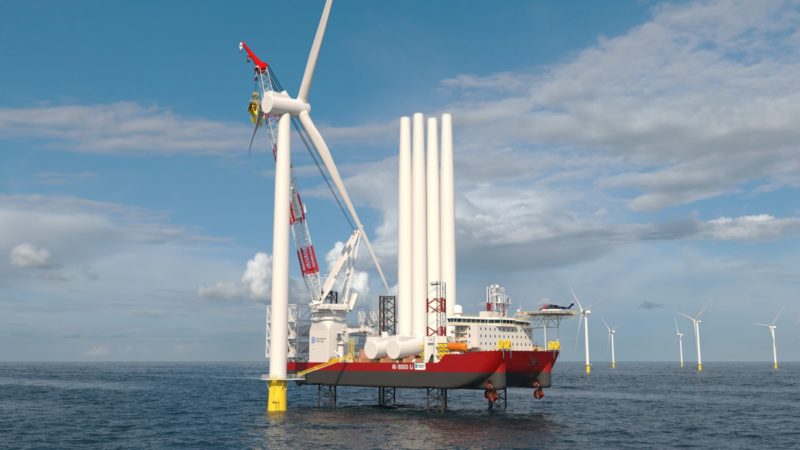Energy analysts at IHS Markit amended their recent report on wind energy installation vessel needs, dropping a suggestion that the United States might need to relax its Jones Act maritime law to gain momentum in developing offshore wind.
The May 5 paper from the Clean Energy Technology unit of IHS Markit was widely reported in the maritime and renewable energy sectors for reinforcing predictions of an imminent global shortfall in WTIVs. Other industry observers have likewise cautioned that the trend toward larger wind turbines in the 12- to 14-megawatt output scale will need a whole newbuild wave of construction vessels for such ambitious offshore projects to be installed.
The IHS analysis concluded that at least four new modern classed WTIVs – at a total cost around $2 billion – would be needed in the next few years for the offshore wind industry to avoid bottlenecks and delays for projects planned in the U.S., Europe and Asia outside of China.
At the moment only one U.S. flag WTIV is under construction, a $500 million project for Virginia-based utility and offshore wind developer Dominion Energy.
Considering the Biden administration’s ambitious goals for expanding offshore wind, the original IHS Markit report predicted that “in order to hit its target, the country must either relax its maritime rules to permit foreign-built vessels to operate or ensure new heavy-weight vessels are built and put into service promptly.”
That drew some attention from the U.S. offshore services industry, which has been challenging viewpoints that the U.S. Merchant Marine Act of 1920 and its related requirements for using U.S. vessels and crews will hobble U.S. wind power development.
It’s one more in the ongoing industry discussions of how fast the U.S. will be able to invest in a new offshore wind industry fleet. For now, wind developers are looking to the so-called feeder barge scenario for building in U.S. waters.
Vineyard Wind, which won a record of decision approval from the Bureau of Ocean Energy Management this week for its 800 MW project off southern New England, will use that arrangement. U.S.-flagged Foss Maritime tugs will haul turbine components from the company’s New Bedford, Mass., staging port for installation at sea by Belgium-based DEME Offshore’s installation vessel.
But for the long term, Dominion Wind concluded the fledging U.S. industry needs the company’s WTIV, now under construction by Keppel AmFELS at Brownsville, Texas.
The 472’x184’x38’ vessel will be one of the largest in class, with a Huisman main crane boom length of 426’ and lifting capacity of 2,200 tons to handle next-generation turbines standing over 800 feet tall.
“A feeder barge solution will work, we’ve seen it work, we’ve used it ourselves,” said Karl Humberson, director of project construction in the Dominion Energy’s Power Generation Group, during a WorkBoat + Wind webinar March 31.
Dominion imported turbine components from Europe via Halifax, Nova Scotia, for installation at its twin turbine, 12 MW Coastal Virginia Offshore Wind pilot project 27 miles off Virginia Beach, Va., using a foreign flag WTIV supported by U.S. flag vessels. That project was a precursor to Dominion’s plan for up to 2.6 gigawatts of offshore wind power capacity east of the Virginia capes.
The feeder barge model worked fine for two turbines, Humberson said, adding: “I wouldn’t do it for a hundred.”
“That’s the reason we’re moving to a purpose-built wind turbine installation vessel,” said Humberson. “As much as a feeder barge solution can work, I think the real question is, is it the optimal way to do the work?”
Dominion planners concluded “OK, this is what the industry needs,” said Humberson. “The wind turbine installation vessel that Dominion is building is actually not for the Dominion project, much as it looks that way. We’re building it for the industry.”
After commissioning in 2023, the company foresees the ship will be busy for years to come.
“The vessel is a merchant vessel. It is there for people to use,” said Humberson. “In offshore wind, this is the right way to do it.”




